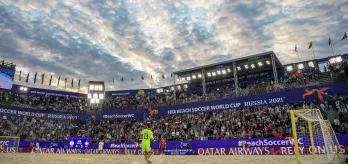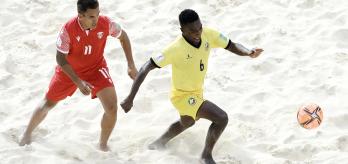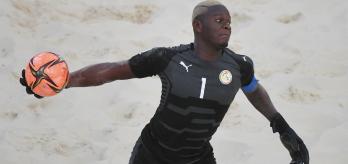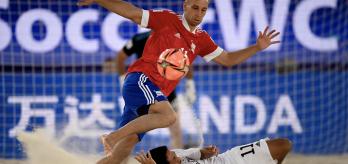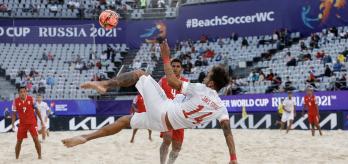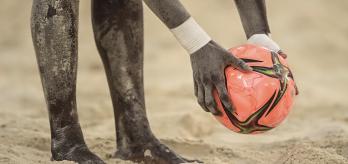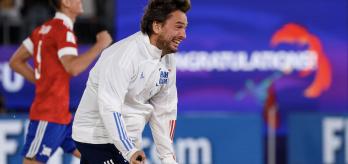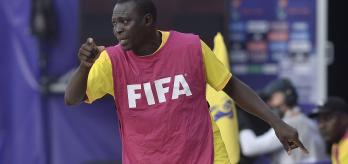Introduction
When you base your game on combination attacks, the aim is to gradually create space, by constantly keeping possession of the ball and exploiting the combined movements of the outfield players and their attacking ability in 1v1 situations. This requires intelligence, talent and the highest level of technical and tactical skill, both when the ball is in the air and particularly when it is in the sand.
Structuring your game around direct attacks, on the other hand, involves attempting to score as quickly as possible and seeking the most direct route with a limited number of passes. This can be done by exploiting both the hands of the “goalkeeper-quarterback”, with long throws directly towards zone 4, and their ability to play long passes with their feet. It is also essential to have attackers with outstanding acrobatic skills and the ability to hold the ball up in order to bring their team-mates into the game. It is fairly obvious that a game based on direct attacks is more simplified, which helps to make up for the absence of individual players’ technical brilliance, but at the risk of limited possession.
A variety of playing styles on display in Russia
At the FIFA Beach Soccer World Cup Russia 2021™, for the first time, the FIFA Technical Study Group tried to identify each team’s prevailing style of play, not only by observing the playing approach adopted by the various national teams during each match, but also by carrying out numerical analysis of the goals scored.
Combination attacks and direct attacks were used by all the participating teams, in different percentages, depending not only on how the teams had been set up by their coaches according to their players' characteristics, but also on the type of opponent and their defensive strategy, as well as on the specific phase of the individual match, linked both to the scoreline and to the remaining playing time.
In most cases, it was not difficult to highlight the prevalence of one style over another, although passages of play were often kicked off with the initial intention of generating a direct attack which ended up turning into a combination attack instead, thanks to attacking players who were capable of keeping possession in zone 4, triggering a new type of move with the support of their team-mates.
While there were teams that never changed their playing style throughout the competition (notably Senegal, which very rarely tried anything other than direct attacks, with the goalkeeper’s long throws starting off moves), others alternated between combination and direct attacks in similar percentages, even within the same match (e.g. Spain).
Combination and direct attacks in a 2-2-System
Among the teams that have made a habit in recent years of basing their attacking play on their goalkeeper's ability to play with their feet, Russia and Switzerland (the former thanks to the duo of Maksim Chuzkov and Stanislav Kosharnyi, the latter thanks to the skills of Golden Glove winner Eliott Mounoud) have adapted the most to the new four-second limit for goalkeepers in possession in their own half of the pitch, keeping the search for combination attacks as a priority among their strategic choices.
The USA must be added to the two semi-finalists, given that despite the team’s premature elimination in the group stage (where both eventual finalists were present), they impressed with the organisation of their combination attacks in a 2-2 formation, centred around the outstanding quality of goalkeeper Christopher Toth, one of the best in the world with the ball at his feet.
Goals from combination attacks
Goals from direct attacks
There was another group of teams (Belarus, El Salvador, Japan, Paraguay, Tahiti) that – always within a clearly prevalent use of the 2-2 formation – adapted to the new rule by opting for a more equal distribution between combination attacks and direct attacks, exploiting the physicality of their attacking players such as Takuya Akaguma and Shusei Yamauchi (JPN), Rubén Batres (SLV), Carlos Carballo (PAR), Anatoliy Ryabko (BLR) and Heirauarii Salem (TAH).
Goals from combination attacks
Goals from direct attacks
Finally, there were teams that, in developing their own attacking phase within a 2-2 system, relied almost exclusively on direct attacks: Oman, and especially Senegal, which clinched a historic fourth place by basing their play almost exclusively on the Al Seyni Ndiaye-Raoul Mendy axis.
Goals from direct attacks
Mozambique proved that they are a special case during their FIFA Beach Soccer World Cup debut. The Africans marked their attacking development by immediately seeking out the forward duo of Nelson and Figo, often without well-defined positioning in the initial construction of the play (prevalence of 2-2).
Goal from combination attack
Goal from direct attack
Combination and direct Attacks in a 3-1-System
None of the teams that opted to build attacks in a 3-1 formation reached the semi-finals of the tournament. Not even the greatest exponents of this style, Brazil and Portugal, managed to live up to the role of favourites that many had attributed to them beforehand.
In the tournament, Brazil and Portugal once again stuck with their traditional 3-1 approach, focusing on continuous possession of the ball and combination attacks by their outfield players, almost all endowed with exceptional individual qualities in 1v1 play (Rodrigo for the South American side and Bê Martins for the Portuguese, to name just two).
The Brazilians alternated between their typical attacking combinations, which often resulted in the 1-2-1 variant, and highly effective direct attacks, as shown by the four goals scored this way.
The Portuguese, on the other hand, quite frequently changed their playing system from 3-1 to 2-2 depending on the stage of the match, and particularly during the few minutes when the unit made up of the Martins twins left the pitch to take a breather. However, the typical 3-1 style was coach Mário Narciso’s preferred choice, despite the costly absence of Jordan, who had been key to the World Cup victory two years ago.
Goals from combination attacks
Goals from direct attacks
Finally, the analysis concludes with the last three teams: Spain, UAE and Uruguay.
The Spaniards, returning to World Cup action after missing out in 2017 and 2019, having eliminated previous runners-up Italy in the European qualifiers, performed their typical attacking game in a 3-1 system, predominantly using direct attacks with goalkeeper Dona’s throws, but also combination attacks by their outfield players with high technical skills.
Uruguay and the UAE were much more insistent on building direct attacks with their goalkeepers, starting from a clear initial 3-1 set-up.
Goals from combination attacks
Goals from direct attacks
In conclusion, it must not be forgotten that the use of combination and direct attacks not only directly allowed the goals listed above to be scored, but also indirectly contributed to the scoring of all goals that came as a result of set plays, given that combination and direct attacks obviously led to winning corners, attacking throw-ins, free kicks or penalties from which many other goals came.










